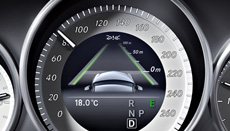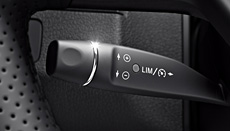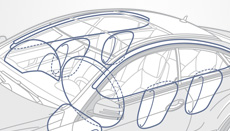Third brake lamp featuring LED technology | |
ADAPTIVE BRAKE with HOLD function, dry braking in the wet and hill start assist The ADAPTIVE BRAKE system improves ride comfort and safety by helping to perform critical braking manoeuvres more safely with the basic function of the ABS anti-lock braking system, while convenience functions support the driver in everyday driving situations. - Supportive HOLD function: the ADAPTIVE BRAKE system's HOLD function, which is activated by briefly depressing the brake pedal, prevents unintentional rolling when stopped at a traffic light or in stop-and-go traffic.
- Extra help: the Hill-Start Assist function prevents the vehicle from rolling back unexpectedly on uphill gradients when moving from the brake to the accelerator pedal.
- Braking effect with no delay: the "brake drying" function removes the film of water that forms on the brake discs in wet conditions.
- For an even quicker response: with the "Priming" option, the brake linings on the brake discs are primed as soon as the driver takes his foot off the accelerator quickly.
| |
Adaptive brake lights, flashing Improved perceptual safety and shorter reaction times for drivers in vehicles following behind: the adaptive brake light can make a significant contribution towards preventing rear-end collisions by indicating to following traffic that an emergency braking manoeuvre is taking place. If the driver initiates an emergency stop from a speed greater than 50 km/h, the brake lights flash in order to warn following traffic.If the vehicle comes to a stop from a speed greater than 70 km/h, the hazard warning lamps are switched on automatically. | |
Airbags for driver and passenger The driver and front passenger airbags can help to protect the upper torso and head in a collision – as well as providing additional stability for the entire body. They are thus able to mitigate the severity of injuries sustained in an accident. If the crash sensors detect a collision of a certain strength, the airbags are deployed. | |
Anti-lock braking system (ABS) The anti-lock braking system (ABS) enhances driving safety, especially in critical braking situations. When braking heavily, ABS reduces wheel locking by modulating the braking pressure for each wheel.
This ensures that the vehicle remains directionally stable and can be steered while maintaining maximum braking power.
In other words: ABS allows the driver to brake and steer simultaneously – allowing precise evasive manoeuvring – in order to avoid an accident. | |
Acceleration skid control (ASR) The acceleration skid control (ASR) ensures that the wheels do not spin when accelerating. Especially when moving off on snow, ice and loose chippings, the acceleration skid control prevents individual wheels from spinning and the vehicle from sliding out to the side. The system uses speed sensors to monitor the slip characteristics of the wheels. If the system senses a wheel is starting to spin, the acceleration skid control corrects the wheel speed by braking and intervening in the engine management system, thus reducing the wheel slip and wheel spin. | |
ATTENTION ASSIST is particularly helpful on long journeys and when driving at night; the system warns the driver if it detects signs of failing attention and increasing fatigue. At speeds between 60 and 200 km/h, ATTENTION ASSIST warns the driver visually and audibly as soon as it detects any signs of drowsiness or inattention. The background: sensors analyse driving behaviour to detect any changes compared with the previously determined individual driver profile. | |
Outside temperature display | |
BAS Brake Assist system with brake force boost upon detection of emergency stop BAS Brake Assist can recognise emergency braking by the speed at which the braking pedal is depressed and can automatically supply full braking power. The anti-lock braking system (ABS) then metres the braking power up to the slip threshold to maintain steering control. Once the driver releases the brake pedal, automatic brake boosting is immediately terminated.
| |
Brake wear warning display | |
COLLISION PREVENTION ASSIST collision warning including Adaptive Brake Assist Too small of a gap between vehicles is one of the main causes of severe accidents. The newly developed radar-based COLLISION PREVENTION ASSIST collision warning system can enhance safety and driving comfort by warning the driver of following too closely or of stationary obstacles and can support the driver's braking when it detects danger.
When travelling at speeds of more than 7 km/h, the system can recognise insufficient gaps to vehicles ahead as well as stationary objects. The forward collision warning is emitted as soon as the vehicle approaches any vehicle detected to the front at a high speed or acceleration. In this case the driver can be warned visually and audibly.
If the system detects a danger and the driver applies the brakes at the same time, Adaptive Brake Assist can intervene for good measure: It then provides precisely the right amount of brake pressure that is needed ideally to avoid an impending collision. COLLISION PREVENTION ASSIST is an innovative component of the Integral Safety Concept of Mercedes-Benz.

| |
ESP® Electronic Stability Program In critical situations, the Electronic Stability Program (ESP®) can help to stabilise the vehicle by applying a braking force to individual wheels, and adjusting engine output. By carrying out targeted braking interventions at individual wheels, ESP® can prevent both over- and understeer, thus enhancing handling safety.
If the ESP® system detects a critical situation, it applies the brakes systematically to one or more wheels according to the situation. Should the system consider it necessary, it will also make an automatic adjustment to engine torque. In this way ESP® helps the driver to stabilise the vehicle within the laws of physics – particularly when cornering and during sudden evasive manoeuvres.
- Central feature: the yaw-rate sensor continuously monitors the vehicle's movement around its vertical axis. ESP® compares the measured actual value with the target value resulting from the driver's steering input and the current speed. The instant the vehicle deviates from this ideal line, ESP® intervenes by working to counteract any swerving movements as they occur.
- Always maximum traction: the integrated ASR traction control system additionally controls wheel slip when accelerating with interventions in the engine management system.
- Enhanced safety: ABS as an integral component of ESP® helps to prevent the wheels from locking and to maintain their steering function.
- Reliable basic functions: ESP® thus now adds a handling stability assistance system to the anti-lock braking system (ABS) and acceleration skid control (ASR) system.
| |
The headlamp assist system reduces the strain on the driver as it can automatically switch on low-beam headlamps, tail lamps and number plate illumination when it gets dark outside. The assistance system performs this task even when it's raining or snowing by electronically detecting the cycles of the windscreen wipers. | |
Fanfare horn, electronic[4] | |
Fluid level warning indicator for fuel, oil, coolant and screen wash | |
Pedestrian protection with active bonnet (reversible) If the system detects a collision, actuators are activated using pyrotechnics and the engine bonnet lifts up using spring force.Additional deformation space is created between the soft bonnet and the hard assembly in the engine compartment. This can reduce the collision energy as a result and lower the risk of severe injuries. The system can then no longer be initiated, and must be brought to a specialist workshop to be repaired. | |
Tail lights with LED technology The LED tail lamps create an unmistakeable night design. All functions are realised with LEDs and to some extent with fibre optics technology. This allows to make LEDs in certain areas of the tail lamp glow at different intensities depending on the light function. The lenses are carried out in red and white.
| |
Heated rear window with timer control The heated rear window prevents the window from icing or misting up due to moisture, ensuring clear visibility to the rear. The timer adjusts the operating time of the heating to the outside temperature and the road speed. | |
ISOFIX child seat attachment points and TopTether fastening points in rear backrest on the upper left and right The ISOFIX child seat attachment points are designed for child seats that use the ISOFIX attachment system. The ease with which this system allows child seats to be secured lowers the risk of their incorrect attachment. A further belt can be attached to each of the additional Top Tether attachment points, which prevents the child seat from tipping forward and therefore makes the child seat attachment system even more stable.
| |
The kneebag installed as standard on the driver’s side helps to protect the legs during impact and also stabilises the entire body. It can thus help mitigate the potential severity of injuries sustained in an accident. If the crash sensors detect a collision of a certain severity, the kneebag is deployed.
| |
Headlamp range adjustment The headlamp beam control adjusts the light cones of the headlamps to the vehicle’s pitch (pitch angle). In this way the lighting of the road ahead is always optimal for the driver, and oncoming road users and vehicles in front are not dazzled. | |
NECK-PRO head restraints for front seats Activated in the event of a rear-end collision, the NECK-PRO luxury head restraints are adjustable for the driver and front passenger and can reduce the risk of sustaining a whiplash injury. If a collision occurs, they provide head support and reduce the load on the spine at an early stage by employing a spring mechanism to thrust the head restraints forward and upwards. After their deployment the head restraints can be manually returned to their original position. | |
PRE-SAFE® system with reversible belt tensioners for driver's and passenger's seat, side window closing function The preventive PRE-SAFE® occupant protection system can recognise critical driving situations and, if necessary, pre-emptively activate reversible safety systems to help reduce the risk of injury to the vehicle occupants. This is based on PRE-SAFE® continuously monitoring sensor data from systems such as ESP® and BAS and identifying driving situations such as oversteer/understeer and emergency stops.
If the typical characteristics of a critical driving situation are identified, the electronic belt tensioners can be activated, the electrically adjustable front-passenger seat moved to a more favourable crash position (only in conjunction with the Memory package) and the side windows and the panoramic sliding sunroof (option) closed automatically, all within a fraction of a second. | |
Tyre pressure loss warning system The tyre pressure loss warning system can promptly warn the driver when it recognises a dangerous drop in pressure in the individual tyres, which helps to prevent accidents. The system monitors the rotational speed of the individual wheels and can deduce significant losses in pressure based on any changes in speed. The warning is provided via a display in the instrument cluster.
| |
| |
Power steering with safety steering column | |
3-point seat belts including automatic belt-height adjustment, reversible belt force limiters and tensioners for driver and front passenger | |
Front sidebags and pelvisbags The sidebags and pelvisbags fitted as standard for the driver and front passenger provide protection to the thorax and pelvis area in the event of a side impact, and also afford additional stability to the entire body. Consequently they can mitigate the severity of injuries sustained in an accident. They are triggered when the central control unit and the side satellite sensors register acceleration or deceleration forces acting on the vehicle in excess of a certain threshold. The sidebags deploy at chest height between the vehicle side and the occupant.
The pelvisbag is deployed in the space between the front-seat occupants’ pelvic region and the door panelling. The pelvisbag then braces itself against the impact area, pushing the occupant’s pelvic region away from the door panelling at a very early stage of the collision.
Sidebags for the rear-seat passengers are available as an optional extra.
| |
Seat occupancy sensor for front passenger seat | |
The STEER CONTROL assistance system can boost safety by providing corrective intervention in the event of oversteering and braking manoeuvres on unequal road surfaces.
The ESP® control unit calculates the additional steering torque required for the respective situation. The electric power assist (EPS) then performs the appropriate steering command. If the vehicle starts to skid, the system can help the driver to countersteer in the right direction with a perceptible pulsation of the steering wheel.
| |
Partial LED headlamps, incl. daytime running lamps and position markers LED dipped-beam headlamps, daytime driving lamps and position markers produce less glare in traffic and thus enhance safety. They start up rapidly and have a long service life. In addition, depending on the function, their energy requirements are considerably lower than those of conventional headlamps, which has a positive effect on the vehicle's energy consumption.
| |
Cruise control with SPEEDTRONIC variable speed limiter Relaxed, fatigue-proof increased ride comfort and fuel-saving driving, in particular on long journeys: the cruise control function allows the driver to set a desired cruising speed. The integrated variable speed limiter (SPEEDTRONIC) enables the driver to set a desired maximum speed, for example, when limits are in force or in 30 km/h zones.
The speed limit is selected in increments of one or ten km/h up to the top speed with the control lever, and is displayed in the instrument cluster. If the preset limit is exceeded, e.g. on downhill stretches, the system autonomously shifts the automatic transmission down a gear and applies the brakes to a certain extent. However, if the braking effect is not sufficient, a warning tone alerts the driver that the service brake must also be applied in order to stick to the desired speed limit.
The variable speed limiter function is an additional function to the familiar cruise-control functions, and can be activated using the cruise control lever. A yellow LED light on the switch and a symbol in the instrument cluster indicate that cruise control mode is turned off and Speed Limit Assist is activated. The speed limiter function is switched off by returning the lever to cruise-control mode, by flicking it to the "OFF" position or by kickdown. 
| |
| |
| |
Warning buzzer and warning indicator in instrument cluster if seat belts are not fastened, parking lamps not switched off or parking brake not applied. | |
Acoustic warning alerts driver if vehicle lighting is not switched off | |
Electronic immobiliser, incl. locking system with three-channel remote control, visual lock confirmation and emergency opening (recognised by AZT and TÜV) | |
In the event of a side impact with a force exceeding a defined threshold value (as well as other accidents with the corresponding lateral dynamics), the windowbag deploys to cover the side windows and reduce the risk of a collision between the passenger’s head and the side of the vehicle or of objects penetrating the vehicle interior. The windowbag is triggered simultaneously with the side- and pelvisbags and always on the side of the vehicle involved in the side impact. Once deployed, the windowbag covers the side panes between the A- and C-pillars like a curtain. The windowbag covers a large part of the side when deployed.
The windowbag provides the following advantages: - Protection potential for the head in a side-on collision.
- Technical design and large volume provide excellent protection even for occupants of different physiques
- The deployment between A- and C-pillar also protects rear passengers in the outside seats.
- Reduces head movement in the event of a direct collision.
- Can reduce the intrusion of splinters and other objects.

| |
Central locking with interior switch, automatic locking (can be deactivated) and crash sensor with emergency opening The central locking system can increase safety, as it can lock all doors automatically when moving off. Vehicle occupants can, however, exit the vehicle quickly in the event of an accident, thanks to the emergency opening initiated by crash sensors. Opening a door or operating the interior central locking switch unlocks the doors. If the vehicle is unlocked using the electronic key but neither a door nor the boot lid is opened before 40 seconds have elapsed, the vehicle is locked once again.
From a speed of about 3 km/h the boot lid is automatically locked, and above a speed of 15 km/h the doors are locked, too. If the crash sensor registers an accident, all the doors and the boot lid are unlocked to enable occupants to exit the vehicle swiftly. | |





